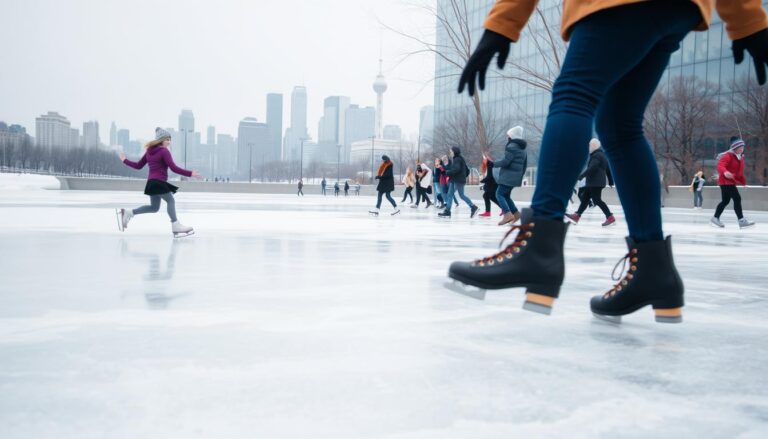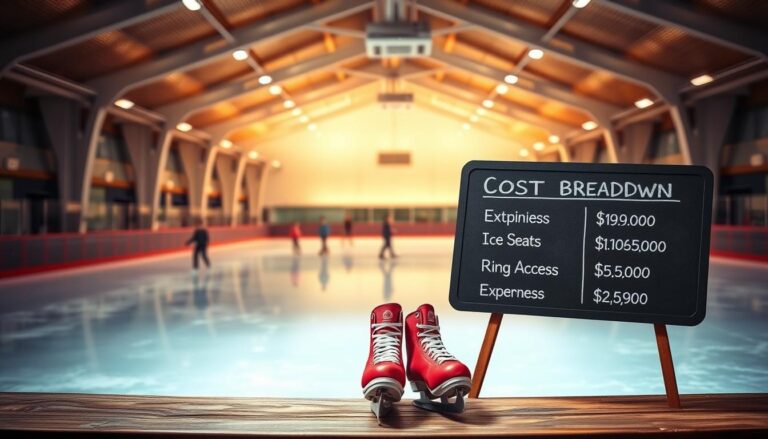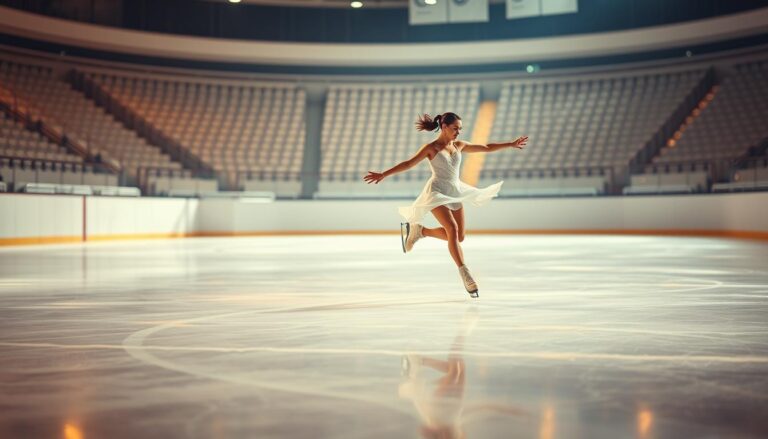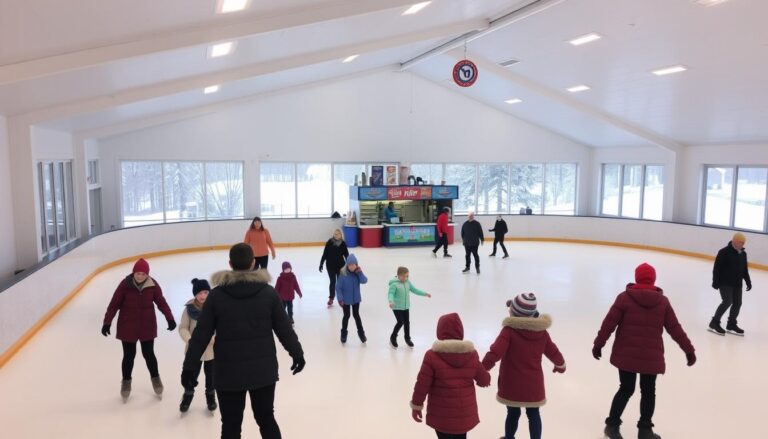Master Ice Skating Basics from the Comfort of Home
Want to master ice skating without going to a rink? You’re in the right spot! Learning ice skating at home is not only possible but also exciting. It can change your athletic abilities.
Ice skating needs precision, balance, and technique. While most training is on ice, modern athletes see home training as key. By setting up a training space at home, you can improve muscle memory and core strength. You’ll also learn the basic movements needed for skating.
Professional skaters and hockey players know off-ice training is vital. Your living room, garage, or basement can be a training spot with the right gear. Home skating tips are about building strength, flexibility, and muscle coordination, not just mimicking moves.
Whether you’re new to skating or an experienced athlete, this guide will help. You’ll learn balance exercises and get tips on equipment. You’ll see how to turn your home into a personal training area.
Home ice skating is easy to access. No need for expensive rink memberships or strict schedules. Just focused training that fits your goals. Get ready to improve your skating skills at home.
Your skating journey begins here. Get ready for an exciting look at home ice skating techniques. They’ll boost your skills and confidence.
Getting Started with At-Home Ice Skating Practice
Turning your home into a place for ice skating practice is simpler than you think. You can start with beginner ice skating drills in your living room. This helps you improve your skills and gain confidence before you skate on real ice.
To get ready for ice skating at home, you need a plan and the right attitude. With a little equipment and lots of enthusiasm, your home can become a great place to train.
Essential Equipment for Home Training
- Balance board for stability training
- Resistance bands for strength conditioning
- Smooth floor surface (hardwood or tile)
- Thick socks for simulating slippery conditions
- Protective gear (knee pads, wrist guards)
Creating a Safe Practice Space
When setting up your skating area at home, safety is key. Move furniture out of the way, make sure the floor is smooth, and have enough room to move around.
| Space Requirement | Recommended Dimensions |
|---|---|
| Minimum Area | 6 x 8 feet |
| Ideal Ceiling Height | 8-10 feet |
| Floor Surface | Smooth, non-carpeted |
Setting Realistic Goals
Improving at ice skating takes time and regular practice. Start with basic beginner ice skating drills. Focus on balance, posture, and basic movements.
- Master static balance first
- Practice weight shifting
- Learn basic gliding motions
- Develop core strength
- Gradually increase complexity of at-home ice skating exercises
Your journey in home training starts with dedication and creativity. By following these steps, you’ll lay a strong foundation for your ice skating future.
How to Practice Ice Skating at Home: Fundamental Techniques
Turning your home into a place for indoor ice skating practice is simpler than you might think. You can’t get real ice, but you can work on important skating skills in your living room. This practice helps build muscle memory, balance, and gets you ready for the ice rink.
To get better at ice skating at home, focus on three main areas:
- Body positioning and balance
- Weight transfer techniques
- Simulated skating movements
Begin with your basic stance. Imagine a perfect skating posture: knees slightly bent, upper body leaning forward, arms relaxed at your sides. Practice this stance on a smooth floor with thick socks or sliding discs to feel like you’re gliding.
| Technique | Home Practice Method | Skill Developed |
|---|---|---|
| Weight Transfer | Side-to-side weight shifts | Edge control |
| Crossover Simulation | Lateral stepping exercises | Coordination |
| Stopping Technique | Quick stopping drills on smooth surface | Balance and control |
Skaters suggest practicing for 15-20 minutes each day. Wear comfy clothes that let you move freely. Choose a smooth, safe area like hardwood or linoleum floors.
Remember, regular practice turns theory into muscle memory. Your home can be the best place to train for ice rink success.
Building Your Home Ice Skating Training Area
Turning your home into a DIY ice skating area needs careful planning. It’s great for both new and experienced skaters. You can improve your skills right in your living room.

Starting a home ice rink involves understanding your space and choosing the right surfaces. You need a smooth, stable area that feels like ice. It should also be safe and help you perform well.
Flooring Requirements and Surface Options
Choosing the right flooring is key for DIY ice skating. Here are some options:
- Synthetic ice tiles
- Roller skating mats
- Smooth hardwood floors
- Specialized skating surfaces
Space Dimensions and Layout Tips
Make the most of your space with smart planning:
- Measure your space carefully
- Make a clear skating area
- Need at least 10×10 feet for basic moves
- Clear out furniture and obstacles
Safety Features to Include
Safety is essential in any home ice rink. Add these important safety features:
- Non-slip floor markings
- Padded wall edges
- Protective floor matting
- Adequate lighting
- Nearby support rails or handles
With careful planning, your home can be the perfect place to practice skating. It helps you improve your skills and gain confidence.
Essential Off-Ice Training Equipment
To turn your home into a place for ice skating training, you need the right gear. Knowing which tools can boost your skills without ice is key. Skaters at every level can get better with exercises that work on strength, balance, and muscle memory.
Important equipment for ice skating exercises at home includes:
- Balance Boards: Develop core stability and edge control
- Resistance Bands: Strengthen skating-specific muscle groups
- Slide Boards: Simulate skating gliding motions
- Jump Ropes: Enhance cardiovascular endurance and coordination
- Foam Rollers: Improve flexibility and muscle recovery
Experts say using versatile tools that mimic ice skating is best. A good balance board helps with body awareness, key for advanced moves.
For those on a tight budget, there are affordable options. Items like yoga mats, sturdy chairs, and smooth floors can be used for training. They help in practicing ice skating tips at home.
| Equipment | Primary Benefit | Estimated Cost |
|---|---|---|
| Balance Board | Core Stability | $50-$100 |
| Resistance Bands | Muscle Strength | $15-$30 |
| Slide Board | Movement Simulation | $100-$250 |
Using these tools in your home training will speed up your skill growth. It will also get you ready for ice skating. Remember, regular practice with the right gear can greatly improve your skating.
Basic Balance Exercises for Ice Skating
Mastering balance is key for any beginner ice skater. It helps you feel more stable and confident on the ice. These exercises boost your core strength and body control, making your skating smoother.
Skating needs great balance, which you can improve at home. The right exercises help you remember movements and stay aware of your space. This is vital for gliding smoothly.
Static Balance Drills
Static balance drills are the base of skating stability. They focus on staying steady and in control:
- Single-leg stand (30-60 seconds per leg)
- Heel-to-toe walking on a straight line
- Closed-eye balance challenge
- Tree pose (yoga-inspired balance position)
Dynamic Balance Activities
After mastering static balance, try dynamic movements. These mimic skating actions:
- Skater hops with controlled landings
- Lunges with rotation
- Side-to-side stability slides
- Pivot turns on a stable surface
Core Stability Exercises
A strong core is essential for better skating. Add these exercises to your routine:
- Planks (standard and side variations)
- Russian twists
- Superman holds
- Bicycle crunches
Pro tip: Consistency is key. Practice these drills 3-4 times weekly to see significant improvement in your skating balance and control.
Strengthening Exercises for Ice Skaters
Building muscle strength is key to better ice skating at home. The right exercises can boost your skills and strengthen the muscles needed for skating.
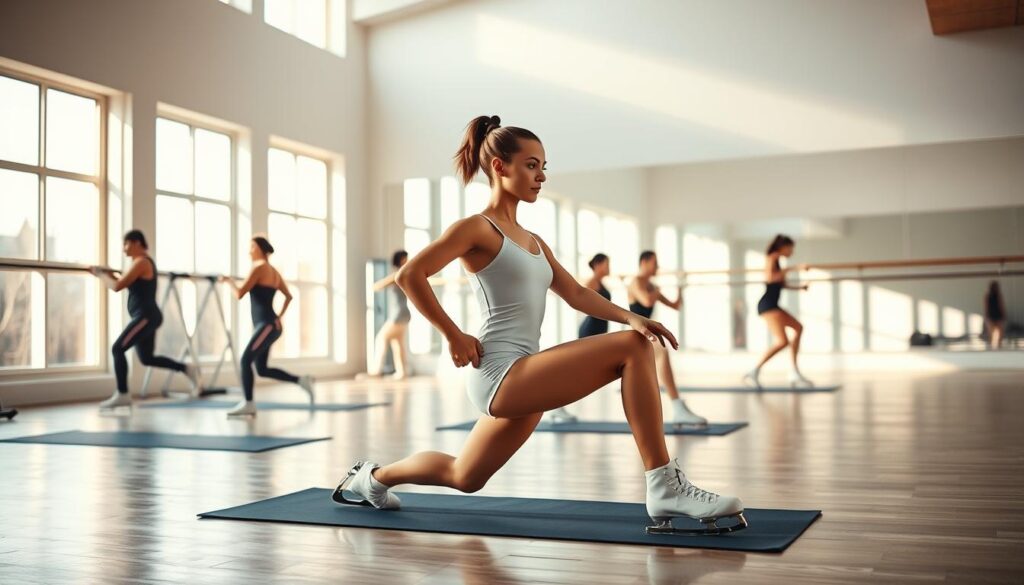
For powerful skating, you need to focus on certain muscles. Skaters should work on muscle groups that help them skate better.
- Lower Body Strength Exercises
- Bodyweight squats with skating-specific positioning
- Single-leg lunges to improve balance
- Plyometric jump training
- Calf raises with lateral movement
- Core Stability Workouts
- Planks with rotational movements
- Russian twists
- Bicycle crunches
- Stability ball exercises
Core strength is vital for ice skating exercises at home. Your midsection helps stabilize you during skating moves. This makes core exercises essential for better skating.
Don’t forget about upper body strength. Exercises with resistance bands and bodyweight can strengthen your arms and shoulders. This is important for powerful skating moves.
| Muscle Group | Key Exercises | Benefit for Skating |
|---|---|---|
| Quadriceps | Jump Squats | Improved Pushing Power |
| Core | Planks | Enhanced Balance |
| Calves | Single-Leg Raises | Better Edge Control |
Professional skaters know strength training is more than just muscle building. It’s about moving with precision, power, and grace. These exercises will help you build the muscles needed for top-notch skating.
Developing Proper Skating Posture at Home
Learning to skate at home starts with knowing how your body should line up. Good posture is key to skating well, even without ice. Skaters who pay attention to their body’s position can skate better and stay safe.
Body Alignment Techniques
When you practice skating at home, how your body is aligned is very important. Your skating stance should follow these main rules:
- Keep your head up and eyes forward
- Maintain a slight bend in your knees
- Center your weight over the middle of your feet
- Engage your core muscles
Common Posture Mistakes to Avoid
Many skaters make mistakes that can hold them back. Be careful of these posture mistakes:
| Mistake | Correction |
|---|---|
| Hunching shoulders | Keep shoulders relaxed and back |
| Locked knees | Maintain a soft, athletic stance |
| Looking down | Focus eyes forward and upright |
Mirror Work Practice
One great tip for practicing at home is using a mirror. Stand in front of a full-length mirror and practice your skating stance. Look at how your body lines up and moves. This helps you learn the right form without ice.
Spending time on these posture tips will help you skate better. Remember, good skating starts with knowing how your body moves and keeping it aligned.
Mastering Edge Work Without Ice
Getting better at ice skating at home is all about mastering edge control. You don’t need real ice to practice. Just use your creativity and some smart training methods. Your living space can become a great place to work on your edges.
Learning edge work means understanding how to distribute your weight and move your body. You can practice ice skating moves with special tools and exercises.
- Balance boards for edge control simulation
- Slide boards to practice lateral movements
- Marked floor surfaces for edge tracing
- Resistance bands for strength training
Improving your indoor ice skating practice is all about focusing on a few key things:
| Training Tool | Edge Work Benefit | Difficulty Level |
|---|---|---|
| Balance Board | Ankle Stability | Beginner |
| Slide Board | Lateral Edge Control | Intermediate |
| Resistance Bands | Muscle Engagement | Advanced |
Try weight shifting exercises to get better at edge control. Start with simple positions and then move to more complex ones. This will help you build muscle memory and boost your skating skills.
Simulating Skating Movements Indoors
Turning your home into a place to practice ice skating is simpler than you think. You can work on important skills without going to the ice. With some creativity and focused practice, you can get better at skating right in your living room.

To make your home a good place to practice, you need the right approach. Your home can be a great place to train with the right techniques and mindset.
Basic Stride Practice
Getting a smooth skating stride starts with knowing how your body works. Try these indoor practice methods:
- Use smooth floor surfaces like hardwood or tiles
- Wear slippery socks to simulate gliding motion
- Practice weight transfer and leg extension
- Focus on maintaining balanced, fluid movements
Stop and Turn Techniques
Being in control is key for safe skating. Indoor exercises can help you get better at precision:
- Practice quick directional changes on a smooth surface
- Use painter’s tape to mark turning points
- Work on weight shifting and edge control
- Develop muscle memory for smooth transitions
Jump Preparation Exercises
Getting ready for skating jumps needs strength and coordination. Use these at-home ice skating exercises to build basic skills:
- Perform off-ice jump training using balance boards
- Practice plyometric exercises for explosive power
- Develop core strength through targeted workouts
- Use resistance bands for leg muscle development
Remember, regular practice turns your living space into a dynamic training area. With hard work, you’ll get the skills you need for ice skating success.
Virtual Ice Skating Learning Resources
Turning your home into a personal ice skating center is now easier than ever. Digital learning platforms have made it possible to improve your ice skating skills at home. You can get professional coaching right in your living room.
Finding the right online resources can really help you skate better. Top platforms offer detailed training. They mix expert teaching with fun, interactive learning.
- Professional video tutorials from Olympic-level coaches
- Interactive mobile apps with real-time technique analysis
- Comprehensive online skating courses
- Community forums for skater networking
Choosing the best virtual ice skating lessons depends on what you need. Some platforms are great for beginners, while others are for those who want to get better at advanced moves.
| Platform | Skill Level | Key Features |
|---|---|---|
| SkateSkills Online | Beginner to Intermediate | Comprehensive technique videos, progress tracking |
| Pro Skating Academy | Intermediate to Advanced | Professional coach feedback, specialized workshops |
| Virtual Skating Connect | All Levels | Community forums, peer learning, global challenges |
Virtual learning platforms offer flexible, personalized ways to improve your ice skating. With online resources, you can work on your technique, strength, and confidence. You don’t need to be in a class all the time.
Technology is changing how we train for sports, and ice skating is no different. Use these digital tools to reach your full skating ability from home.
Incorporating Off-Ice Jump Training
Improving your ice skating skills starts with off-ice training. Beginner ice skating drills can boost your jumping ability without ice. Learning jump mechanics builds muscle memory and confidence.
Building jump skills at home needs a structured plan. Focus on training techniques that enhance strength, coordination, and precision. This way, you can improve your ice skating skills at home.
Jump Progression Steps
Learning jumps requires a step-by-step approach. Here are the key steps:
- Start with basic ground hops
- Practice jump takeoff positions
- Develop core strength exercises
- Simulate jump rotations
- Build ankle and leg stability
Landing Mechanics
Correct landing technique is vital for safety and better performance. Focus on these key elements:
- Soft knee bend
- Balanced weight distribution
- Controlled arm positioning
- Consistent body alignment
Safety Considerations
| Safety Area | Recommended Practice |
|---|---|
| Practice Surface | Use padded or spring floors |
| Protective Gear | Wear supportive shoes and knee pads |
| Warm-up | Complete dynamic stretching routine |
| Progression | Gradually increase jump complexity |
Remember, consistency and patience are key in jump skill development. Start slow and focus on technique, not height or complexity.
Flexibility Training for Skaters
Flexibility is key for ice skaters wanting to get better at home. Exercises that stretch can really help your performance and lower injury risk. Skaters need special flexibility training that’s different from regular stretching.
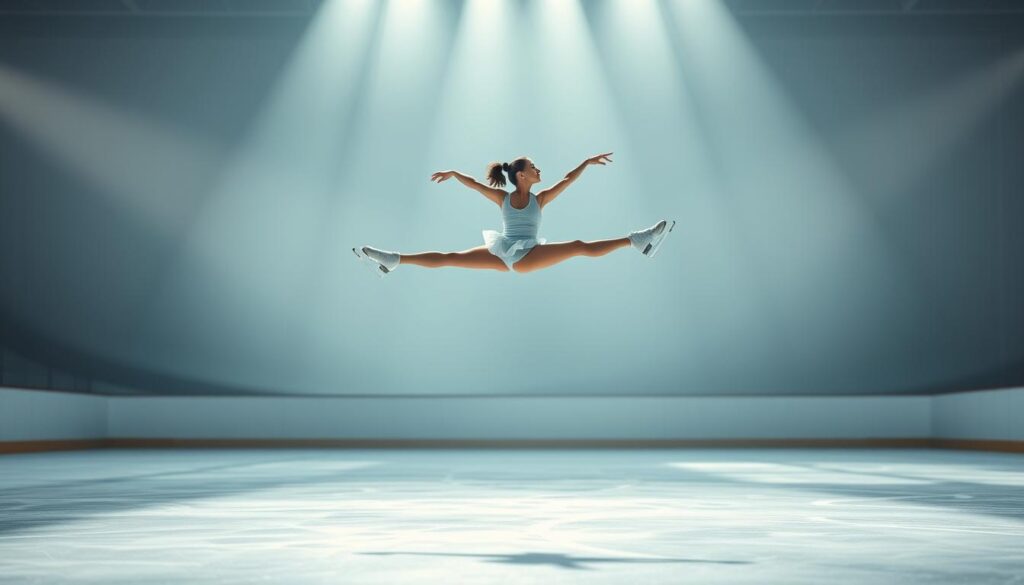
Improving your ice skating at home starts with focused flexibility exercises. Your body needs to be able to move in specific ways for smooth skating.
- Dynamic stretching mimics skating movements
- Static stretches improve overall range of motion
- Yoga poses complement skating-specific flexibility
Professional skaters know flexibility is more than just stretching. It’s about making smooth, powerful moves that help on the ice. Here are the main flexibility areas for skaters:
| Muscle Group | Recommended Stretch | Duration |
|---|---|---|
| Hamstrings | Standing Forward Fold | 30-45 seconds |
| Hip Flexors | Low Lunge Stretch | 20-30 seconds each side |
| Lower Back | Seated Spinal Twist | 15-25 seconds each side |
Creating a regular routine of at-home exercises can change your skating. Start slow, listen to your body, and slowly get more flexible. Remember, getting better takes time and patience.
- Practice stretches 3-4 times per week
- Hold each stretch without bouncing
- Breathe deeply and maintain proper form
Skaters who stick to flexibility training will see big improvements. They’ll get better balance, power, and technique. Your body will move more smoothly and easily on the ice.
Maintaining Skating Skills During Off-Season
Skating fans face a big challenge when ice is scarce. Home ice skating tips are vital to keep your skills sharp. A well-planned off-season training can keep you ready for the rink.
Year-Round Training Schedule
Having a solid training plan is essential. Your off-season should cover three main areas:
- Cardiovascular Conditioning: Keep fit with running, cycling, or swimming
- Strength Training: Work on leg muscles and core strength
- Flexibility Work: Focus on stretching and mobility
Progress Tracking Methods
Tracking your progress is key to staying motivated. Here are some ways to do it:
- Use fitness apps to track your progress
- Keep a detailed journal of your workouts
- Record videos of your practice
- Set goals for each month
Adaptation Strategies
Being flexible is important. Create workouts that can change based on space, equipment, and time. Include balance exercises, plyometrics, and off-ice skating to stay connected.
Consistent practice turns off-season challenges into growth opportunities. With hard work and smart training, you’ll be ready to skate smoothly when you return.
Transitioning from Home Practice to Ice
When you’re ready to move from practicing at home to real ice, it’s a big step. It’s both thrilling and a bit scary. But don’t worry, your home practice has prepared you well.
Stepping onto the ice for the first time, remember all you’ve learned at home. It’s a great start, but you’ll need to make a few tweaks. Your practice has helped you develop muscle memory and balance.
- Start with familiar movements you practiced at home
- Maintain the posture and balance techniques you developed
- Take slow, controlled steps initially
- Use your home-trained core strength for stability
Getting mentally ready is key. The ice might feel different from your practice area. Stay confident and remember the skills you’ve developed. Your hard work has built muscle memory and strength for ice skating.
Skating coaches suggest starting slow. Begin with basic glides and simple moves you’ve mastered. Your home practice has given you a head start in understanding skating.
- Wear protective gear for added confidence
- Practice near the rink’s edge initially
- Focus on maintaining the techniques you learned at home
- Be patient with yourself during the transition
Your hard work at home has given you a solid base. Enjoy the chance to use your skills on real ice. Every moment on the ice is a chance to grow and improve.
Conclusion
Turning your home into a place to practice ice skating is more than just practice. It’s a smart way to get better at skating. By using these tips, you’ve found out that you can improve your skills without going to the rink all the time. Your living room, hallway, or garage can be your own personal training area.
The skills you’ve learned at home will help you a lot in the future. You’ve been practicing balance and edge work, which gets you ready for real ice. Showing dedication to training off the ice shows you’re truly committed to getting better.
Every pro skater began where you are now: practicing and learning. Your hard work in understanding your body, getting stronger, and imagining your moves will make you skate better. The skills you’re gaining are not just for skating. They’re about discipline and pushing your limits.
Your skating journey is special to you. Enjoy the process, celebrate your wins, and keep learning. The rink is waiting for you with your new skills. With regular practice, you’ll go from a home training enthusiast to a confident, graceful skater. Your adventure is just starting—keep going!

